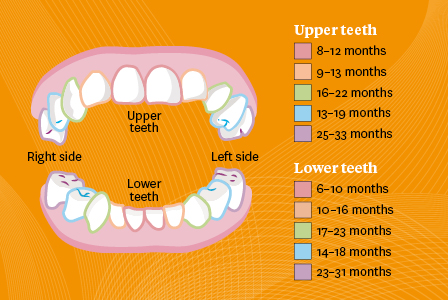Teething
When teeth come through
The lower (bottom) front teeth usually come through the gum first. These are followed by the upper (top) front teeth. The picture below shows when each tooth usually appears.

Symptoms of teething
Many babies’ teeth come through without any problems. But for some, the gums swell and become sore as teeth break through. Your teething baby may:
- cry
- have a slight fever
- have red cheeks
- drool
- not eat or sleep well
- want to bite something hard.
Relieving teething symptoms
If your pēpi is upset, gently rub their gums with a clean finger or the back of a cold spoon. You can also wrap ice cubes in a wash cloth and place the cloth on your baby’s cheek. Give them something to chew on, such as a clean teething ring. You can also buy teething gels from your chemist.
Related websites
HealthEd external link
Free basic oral health service, advice about cleaning and looking after teeth, healthy food for healthy teeth.
New Zealand Dental Association external link
See the section on infants’ and toddlers’ teeth, and the Lift the Lip video.